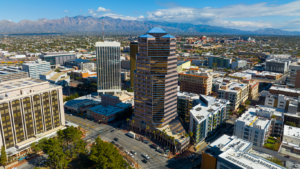As the seasons start to change, offering cooler temperatures in the Valley of the Sun, Phoenix is continuing to play “catch up” after record-breaking heat caused extra drying, furthering the drought that has been years in the making.
“Similar to the last five months, October was extremely dry across Arizona,” said Shauna Evans, public information officer for the Arizona Department of Water Resources. “As a result, drought conditions worsened throughout the state.”
According to phoenix.gov, Arizona has been in drought conditions for 15 years, and has “surpassed the worst drought in more than 110 years of official record-keeping.”
Phoenix residents have been doing their part by taking initiative in water conservation and sustainability. After a 20-year observance period, it was recorded by the City of Phoenix that despite a 30% increase in population from 1994 to 2013, the average water usage per person dropped 25%.
Mara Blakslee, 19, has been a Phoenix resident all her life, and emphasized that conservation is important to the community.
“In a place like Phoenix that experiences droughts and can be very warm for most of the year, residents are taught to save water whenever we can,” Blakslee said.
Evans emphasized that “whether it’s winter or summer, the Arizona Department of Water Resources always encourages residents to do their part conserving and protecting our water.”
Evans also said the “extreme heat and dry conditions this season led to increased evaporation from water bodies and soil.”
This past summer has been the hottest recorded summer to date, with the National Weather Service confirming Phoenix hit 144 days with triple-digit heat. The previous record was 143 days in 1989.
Monsoon season also occurs during the summer, which proved to be going through a dry spell as well, offering only about an inch of rainfall, less than half of a normal measurement. However, Phoenix does not rely on rainfall for its main source of water.
The Central Arizona Project (CAP) is a canal system ushering in water from the Colorado River to the Valley and Tucson. CAP and the Salt River Project, another canal system, account for over 95% of the drinking water supplied in the cities, according to phoenix.gov. The remainder of the supply is groundwater pumped through a well system.
As the drought persists, Blakslee says that she will be more intentional when it comes to water use, hoping others will too.
“People need to be more aware of their water use, myself included,” she said.
Water conservation and drought awareness will be on the minds of Phoenix residents for the future as the National Weather Service is predicting an overall “above average” temperature for the remainder of 2020 and upcoming year 2021.
“The seasonal outlook through the winter indicates a high likelihood of drought persisting and even expanding through Arizona,” Evans said.
In 2003, the Governor’s Drought Task Force was crafted “to establish a flexible framework to refine Arizona’s drought monitoring process,” Evans said. It also helps explain various drought impacts and “identify mechanisms for limiting future vulnerability to drought.” This ensures the state’s preparedness for long-term droughts, such as the current one.
Both Evans and the National Weather Service confirmed that temperatures are expected to stay warm regardless of the season, and the drought is here to stay.




